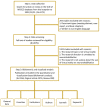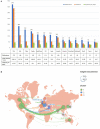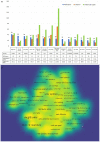Virtual reality for neurorehabilitation: A bibliometric analysis of knowledge structure and theme trends
- PMID: 36438265
- PMCID: PMC9684719
- DOI: 10.3389/fpubh.2022.1042618
Virtual reality for neurorehabilitation: A bibliometric analysis of knowledge structure and theme trends
Abstract
Background: As an emerging technology, virtual reality (VR) has been broadly applied in the medical field, especially in neurorehabilitation. The growing application of VR therapy promotes an increasing amount of clinical studies. In this paper, we present a bibliometric analysis of the existing studies to reveal the current research hotspots and guide future research directions.
Methods: Articles and reviews on the related topic were retrieved from the Science Citation Index Expanded of Web of Science Core Collection database. VOSviewer and Citespace software were applied to systematically analyze information about publications, countries, institutions, authors, journals, citations, and keywords from the included studies.
Results: A total of 1,556 papers published between 1995 and 2021 were identified. The annual number of papers increased gradually over the past three decades, with a peak publication year in 2021 (n = 276). Countries and institutions from North America and Western European were playing leading roles in publications and total citations. Current hotspots were focused on the effectiveness of VR therapy in cognitive and upper limb motor rehabilitation. The clusters of keywords contained the four targeted neurological diseases of VR, while the burst keywords represented that the latest studies were directed toward more defined types of VR therapy and greater study design.
Conclusions: Our study offers information regarding to the current hotspots and emerging trends in the VR for rehabilitation field. It could guide future research and application of VR therapy in neurorehabilitation.
Keywords: bibliometric; hotspots; neurorehabilitation; research trends; virtual reality.
Copyright © 2022 Guo, He, Su, Tan, Han, Gui, Chen, Jiang and Gao.
Conflict of interest statement
The authors declare that the research was conducted in the absence of any commercial or financial relationships that could be construed as a potential conflict of interest.
Figures







Similar articles
-
Research Hotspots and Trends of Virtual Reality Intervention for Stroke: Bibliometric Analysis.JMIR Serious Games. 2025 Apr 16;13:e65993. doi: 10.2196/65993. JMIR Serious Games. 2025. PMID: 40237650 Free PMC article.
-
Research Status and Emerging Trends in Virtual Reality Rehabilitation: Bibliometric and Knowledge Graph Study.JMIR Serious Games. 2023 Mar 6;11:e41091. doi: 10.2196/41091. JMIR Serious Games. 2023. PMID: 36877556 Free PMC article.
-
Research hotspots and trends of transcranial magnetic stimulation in Parkinson's disease: a bibliometric analysis.Front Neurosci. 2023 Oct 19;17:1280180. doi: 10.3389/fnins.2023.1280180. eCollection 2023. Front Neurosci. 2023. PMID: 37928722 Free PMC article. Review.
-
Systematic Bibliometric Analysis of Research Hotspots and Trends on the Application of Virtual Reality in Nursing.Front Public Health. 2022 May 19;10:906715. doi: 10.3389/fpubh.2022.906715. eCollection 2022. Front Public Health. 2022. PMID: 35664095 Free PMC article.
-
Bibliometric Analysis of Research in Pediatrics Related to Virtual and Augmented Reality: A Systematic Review.Curr Pediatr Rev. 2024;20(2):178-187. doi: 10.2174/1573396319666230214103103. Curr Pediatr Rev. 2024. PMID: 36786143
Cited by
-
Knowledge mapping of induced membrane technique: a scientometric study from 2004 to 2023.J Orthop Surg Res. 2024 Sep 28;19(1):600. doi: 10.1186/s13018-024-05093-0. J Orthop Surg Res. 2024. PMID: 39342348 Free PMC article. Review.
-
A bibliometric analysis of cerebral palsy from 2003 to 2022.Front Neurol. 2024 Apr 2;15:1292587. doi: 10.3389/fneur.2024.1292587. eCollection 2024. Front Neurol. 2024. PMID: 38628701 Free PMC article.
-
Challenges in using virtual reality technology for pain relief.World J Clin Cases. 2025 Jun 6;13(16):103372. doi: 10.12998/wjcc.v13.i16.103372. World J Clin Cases. 2025. PMID: 40487545 Free PMC article.
-
Digital Technology Enablers of Tele-Neurorehabilitation in Pre- and Post-COVID-19 Pandemic Era - A Scoping Review.Int J Telerehabil. 2024 Jun 28;16(1):e6611. doi: 10.5195/ijt.2024.6611. eCollection 2024. Int J Telerehabil. 2024. PMID: 39022438 Free PMC article.
-
Research Hotspots and Trends of Virtual Reality Intervention for Stroke: Bibliometric Analysis.JMIR Serious Games. 2025 Apr 16;13:e65993. doi: 10.2196/65993. JMIR Serious Games. 2025. PMID: 40237650 Free PMC article.
References
MeSH terms
LinkOut - more resources
Full Text Sources
Research Materials
Miscellaneous

